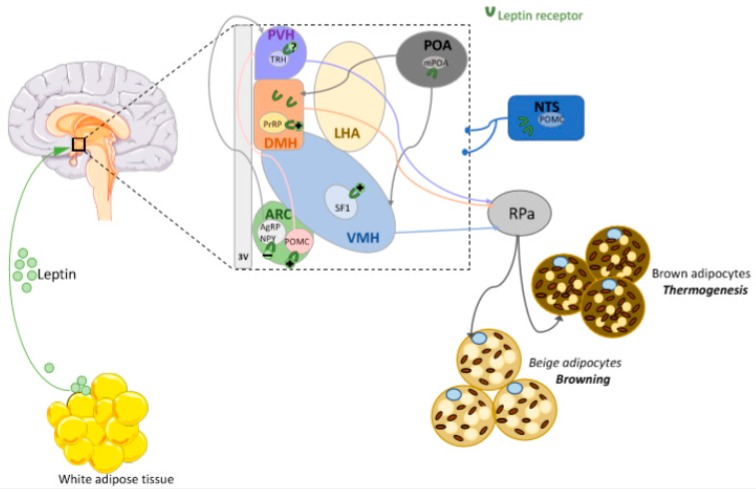Figure 4.
Hypothalamic leptin-sensitive neurons regulating thermogenesis and browning. The leptin receptor (LepR) is highly expressed in several hypothalamic areas implicated in the thermogenic program. The Dorsomedial Hypothalamus (DMH) (high density of LepR), the Preoptic Area (POA) and the Steroidogenic Factor 1 (SF1) expressing neurons of the ventromedial hypothalamus (VMH) have a significant role in the control of the Sympathetic Nervous System (SNS) outflow to the brown adipose tissue (BAT) and the white adipose tissue (WAT) to control thermogenesis and browning respectively. Neurons in these areas are interconnected and can control the sympathetic activity regulating downstream effector neurons in the Raphe Pallidus (RPa). The Arcuate nucleus of the hypothalamus (ARC) also has high expression of LepR: different ARC neuronal populations exert opposing effects on the thermogenesis through the inhibition of Agouti-Related Protein (AgRP)/Neuropeptide Y (NPY) neurons and activation of Pro-opiomelanocortin (POMC) ones. These neurons can act on the Paraventricular nucleus of the hypothalamus (PVH) to decrease or induce thermogenesis respectively. LepR is also expressed in extra-hypothalamic areas, such as POMC neurons in the Nucleus of the Solitary Tract (NTS); these neurons project to different hypothalamic nuclei but their actions are distinct from the POMC expressing neurons of the ARC. Although LepR is expressed in the PVH the role of the PVH in regulating thermogenesis is not completely clear, likely via indirect connections with another nucleus. TRH: thyrotropin-releasing hormone. PrRP: prolactin releasing peptide. mPOA: medial POA.

